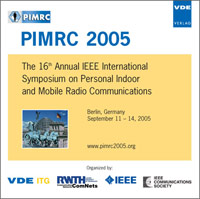Interference Mitigation in TDD Fixed Broadband Wireless Access Using Channel Assignment and Antenna Arrays
Conference: PIMRC 2005 - 16th Annual IEEE International Symposium on Personal Indoor and Mobile Radio Communications
09/11/2005 - 09/14/2005 at Berlin, Germany
Proceedings: PIMRC 2005
Pages: 5Language: englishTyp: PDF
Personal VDE Members are entitled to a 10% discount on this title
Authors:
Ntagkounakis, Konstantinos E.; Dallas, Panos I. (Emerging Technologies & Markets, INTRACOM S.A., 19.5 Markopoulou Ave., 19002 Peania, Greece)
Ntagkounakis, Konstantinos E.; Sharif, Bayan S. (School of Electrical, Electronic & Computer Engineering, University of Newcastle, Mertz Court, Newcastle upon Tyne, NE1 7RU, UK)
Abstract:
In Time Division Duplex (TDD) Fixed Broadband Wireless Access networks, co-channel interference that arises from the correlation of downlink and uplink signals in different sectors may considerably degrade the spectral efficiency. To overcome the complexity and costs of complete frame-TDD boundary synchronization in the network, a combined Channel Assignment (CA) and Antenna Array (AA) approach is proposed to mitigate interference. First a Rotated-Interleaved CA (RICA) scheme is applied, which exploits sector antenna directivity to reject the majority of interferers by receiving them through the antenna side and back lobes. Combined with RICA, an AA system is used in the base station side to further reduce intersector interference during both transmission and reception phases. For the worst-case interference scenario an Unsynchronized TDD scheme, the proposed methodology achieves a 51.5% improvement in the average channel capacity while it considerably improves the uplink availability. An advantage of this approach is that it considers only lowcomplexity AA system configurations, thereby optimizing the corresponding cost.


